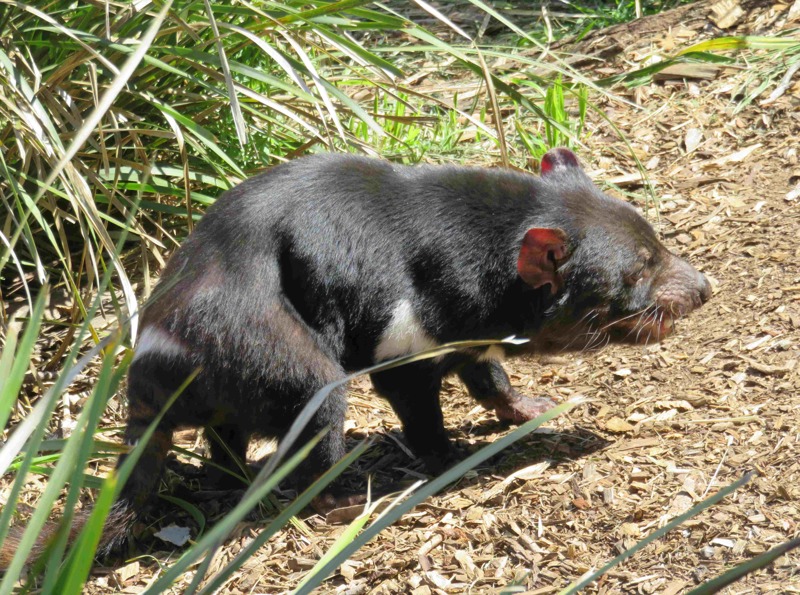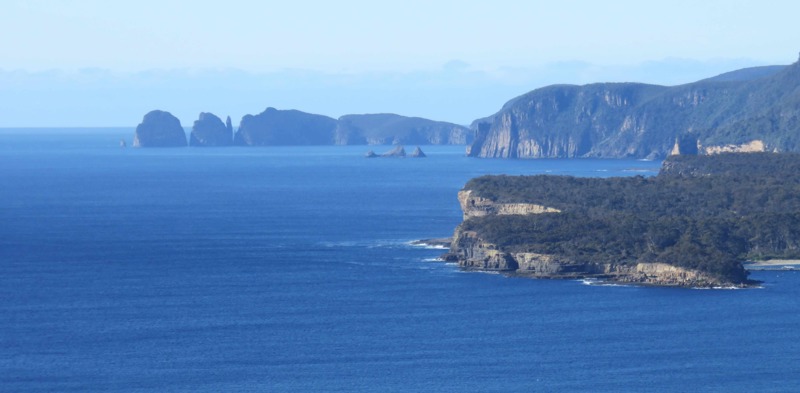Gma's & Gpa's Great Adventures
Ah, our last hurrah while in Australia. Though many Aussies haven't even been here, it would have been a dirty shame to spend as much time in OZ as we did and not see TAZ! ...and a Devil or two...& native black swans!
After landing in Hobart, we had enough time to make it to the Saturday Salamanca Market – bought Gpa a warm wool hat made from Tassie wool (there are so many sheep on this island!) and a delicious bratwurst which seem to be as popular (& as good!) here as in WI. There were also several booths selling their local beer, wine or whisky.
In the late 1980’s, on a fishing trip to Tasmania, Bill Lark asked, “I wonder why there isn’t anyone making malt whisky in Tasmania?” He was eventually
RUTH METZ
43 chapters
We Went to Tassie!
October 05, 2024
|
Tasmania
Ah, our last hurrah while in Australia. Though many Aussies haven't even been here, it would have been a dirty shame to spend as much time in OZ as we did and not see TAZ! ...and a Devil or two...& native black swans!
After landing in Hobart, we had enough time to make it to the Saturday Salamanca Market – bought Gpa a warm wool hat made from Tassie wool (there are so many sheep on this island!) and a delicious bratwurst which seem to be as popular (& as good!) here as in WI. There were also several booths selling their local beer, wine or whisky.
In the late 1980’s, on a fishing trip to Tasmania, Bill Lark asked, “I wonder why there isn’t anyone making malt whisky in Tasmania?” He was eventually

granted the first distiller’s license in Tasmania in 154 years. A new industry was born and Tasmania is now known for its Whisky. We tried hard but needed more than a week to visit all the 27 breweries, 80+ Whisky distilleries, 230 vineyards and numerous artisan cheesemakers in Tasmania. Always need to leave something to come back for!
We got our art fix at MONA, the playground of David Walsh, who grew up in Tassie (just down the road from MONA), dropped out of uni, played cards, won (he’s a successful multi-millionaire gambler with an equally bizarre American wife), did some other stuff, and opened a small museum of antiquities to which no one came. He declared it a triumph and decided to expand. The result is MONA, Museum of Old and New Art, a temple to secularism, rationalism, and talking crap about stuff you really don’t know very much about. There’s art, sculpture and exhibitions and stuff but also live music, food, wine, bars, restaurants, cellar door, accommodation, library, recording studio, an artsy playground, trampoline & tennis court. MONA was designed to be explored—as a space of wonder and experiment. Loved it! …including the Carcass in the Swamp we had for lunch and the performance art entertainment – never knew an accordion could sound like that and the exquisitely attired and performed slow dancing muse was a spicy addition to our lunch.
A short ferry ride took us to Bruny Island’s soaring sea cliffs & coastal heathlands. A narrow isthmus of land, the Neck, connects north and south Bruny Island and is home to a colony of Fairy Penguins. Bruny is the same size as Singapore, but with only 700 residents vs 5.5 million. With lots of wilderness, trees, rugged shoreline and gravel roads, Bruny is known for its oysters, wine, chocolate, cheese, honey, cider and Atlantic Salmon which are farmed in the water around the island – a billion $ industry here. We found The Bruny Island Baker Bread Fridge – 2 retro fridges on the corner of 2 country roads filled daily with locally baked sourdough sold on the honor system. Finally found the one and only place on the island to buy our Flat Whites. Hiked up to the Cape Bruny Lighthouse, Australia’s second oldest lighthouse – with beautiful views, especially looking south where the next stop is Antarctica. Bruny is truly remote, where you can breathe in the wild air that smells of pine and eucalyptus. A good place to go if you need a digital detox.
Though Aboriginal Australians lived here for 40,000+ years, Abel Tasman (a Dutchman) "discovered" the islands in 1642 and claimed the land for the Netherlands. He named it Van Diemen’s Land, after the Governor of the Dutch East Indies (now Indonesia). By the 1800’s British sealers and whalers had set up camps around Van Diemen’s Land; the British had taken complete control. Between 1804 and 1853, more than 70,000 convicts were forcibly shipped here and put to hard labor building, mining, pining and farming for the state and private landowners. Van Diemen’s Land had become Australia’s largest and most notorious penal settlement, known for its harsh conditions, physical punishments and mental abuse. The name was eventually changed to Tasmania to rebrand the island away from its dark convict history, honoring its initial explorer, Abel Tasman.
Visits to Port Arthur and the Richmond Gaol historic sites provided a chilling understanding of how tough life was for the convicts (some hard criminals, some convicted of petty crimes like stealing a loaf of bread to feed the family) and of the jailers (some convicts became jailers; some jailers became convicts). The Richmond Gaol is the oldest jail, built by convict labor. The several short stories of individual convicts really take you back in time to the hard lives of the hundreds of men, women and children who passed through these doors. A sad, disturbing history of mankind.
Besides the gaol, the historic village of Richmond has many well-preserved buildings and homes from the early 1800’s – now many shops, galleries, cafés and guest houses. The Richmond Bridge is the oldest bridge in Australia, completed in 1825, built by convicts and still in use. Richmond also has Australia's oldest, still active Catholic church, St. John's, built in 1836.
We drove along Freycinet Peninsula’s granite mountains and wild coastline with pristine white sand beaches, blowholes & orange-hued granite rocks.
We visited the Bonorong Wildlife Sanctuary where, with their onsite veterinary clinic, they rescue, rehabilitate and release or provide refuge for injured or orphaned native Tasmanian wildlife. We were able to see the elusive Tasmanian Devil, Quolls, Bettongs, Echidna, Wombats and more.
Rode the chairlift over (longest single span chairlift in the world) and walked the suspension bridge back over the scenic Cataract Gorge in Launceston, saw unusual zeolite crystals, visited a brewery and art gallery, winding up our day with a delicious meal of seafood chowder and lamb shoulder at THE METZ! (Who knew!?)
QUICK FACTS:
• Tasmania includes 1000 surrounding small islands.
• Named after their terrifying scream, Tasmanian Devils are actually small marsupials (size of small dogs), and are carnivorous scavengers, preferring to eat dead animals and roadkill, often becoming roadkill themselves.
• The extremely rare Tessellated Pavement, fractured tile-like shoreline rocks formed 300 million years ago, found in only a few places on earth.
How many words was that??
XOXOXOXO
Gma & Gpa

1.
We're Back!
2.
Marlborough District
3.
Kaikoura
4.
Christchurch and beyond...
5.
Steampunk & a Castle?
6.
Te Anau
7.
Milford Sound
8.
Queenstown
9.
Little Paradise
10.
Happy Birthday to Gma!
11.
Glacier Country
12.
Now Where??
13.
The Wild Side
14.
It's Just Another Day
15.
Wonderland
16.
More Places to Go...
17.
Happy Birthday to Gpa!
18.
Love It Here!
19.
Let 'er Loose!
20.
Crossing the Ditch
21.
Sydney
22.
Taronga Zoo
23.
to Bundy
24.
Coddiwomple
25.
Found It!
26.
Something New!
27.
Adjusting Our Sails
28.
Back to the Islands
29.
Maggie Island
30.
Hinchinbrook
31.
Gone fishin'
32.
Cairns
33.
Low Isles
34.
Agincourt Reef
35.
Ribbon Reefs
36.
Lizard Island
37.
Cooktown
38.
Time to Head South
39.
Out and About
40.
It's Time to Go
41.
Onward Ho!
42.
K'gari | Fraser Island
43.
Carnival of Flowers
44.
Australia Zoo
45.
Where, Oh Where Did the Metzes Go??
46.
We Went to Tassie!
47.
The End
Share your travel adventures like this!
Create your own travel blog in one step
Share with friends and family to follow your journey
Easy set up, no technical knowledge needed and unlimited storage!